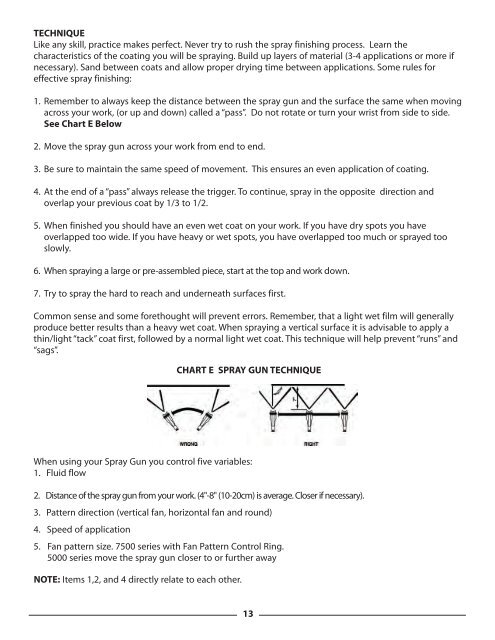record of turbine maintenance - Apollo HVLP
record of turbine maintenance - Apollo HVLP
record of turbine maintenance - Apollo HVLP
You also want an ePaper? Increase the reach of your titles
YUMPU automatically turns print PDFs into web optimized ePapers that Google loves.
TECHNIQUE<br />
Like any skill, practice makes perfect. Never try to rush the spray finishing process. Learn the<br />
characteristics <strong>of</strong> the coating you will be spraying. Build up layers <strong>of</strong> material (3-4 applications or more if<br />
necessary). Sand between coats and allow proper drying time between applications. Some rules for<br />
effective spray finishing:<br />
1. Remember to always keep the distance between the spray gun and the surface the same when moving<br />
across your work, (or up and down) called a “pass”. Do not rotate or turn your wrist from side to side.<br />
See Chart E Below<br />
2. Move the spray gun across your work from end to end.<br />
3. Be sure to maintain the same speed <strong>of</strong> movement. This ensures an even application <strong>of</strong> coating.<br />
4. At the end <strong>of</strong> a “pass” always release the trigger. To continue, spray in the opposite direction and<br />
overlap your previous coat by 1/3 to 1/2.<br />
5. When finished you should have an even wet coat on your work. If you have dry spots you have<br />
overlapped too wide. If you have heavy or wet spots, you have overlapped too much or sprayed too<br />
slowly.<br />
6. When spraying a large or pre-assembled piece, start at the top and work down.<br />
7. Try to spray the hard to reach and underneath surfaces first.<br />
Common sense and some forethought will prevent errors. Remember, that a light wet film will generally<br />
produce better results than a heavy wet coat. When spraying a vertical surface it is advisable to apply a<br />
thin/light “tack” coat first, followed by a normal light wet coat. This technique will help prevent “runs” and<br />
“sags”.<br />
When using your Spray Gun you control five variables:<br />
1. Fluid flow<br />
2. Distance <strong>of</strong> the spray gun from your work. (4"-8" (10-20cm) is average. Closer if necessary).<br />
3. Pattern direction (vertical fan, horizontal fan and round)<br />
4. Speed <strong>of</strong> application<br />
CHART E SPRAY GUN TECHNIQUE<br />
5. Fan pattern size. 7500 series with Fan Pattern Control Ring.<br />
5000 series move the spray gun closer to or further away<br />
NOTE: Items 1,2, and 4 directly relate to each other.<br />
13




